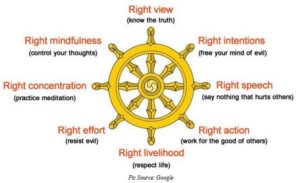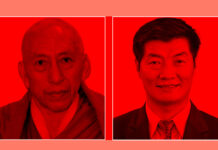Prof. Madhu Rajput* & Sqn Ldr Toolika Rani (retd)*
(TibetanReview.net, Jun02’20)
Sitting comfortably in our house, as we reminisced about the freedom to go out at will, now snatched by an invisible virus, our eyes fell on a photograph on our wall. A happy and contented face, flanked by two women smiled benevolently at us. And it suddenly struck me, “from where does this person and his people get so much depth to not get bitter and sulky despite having been driven out of their homeland?” “What enables them to take such a grave loss of their freedom, identity, lives of dear ones in their strides and still preach the lesson of love and compassion and never of revenge?” We could suddenly relate more to our Tibetan brothers and sisters, even though the pain they must have gone through could only be imagined. A painting of Buddha with meditating eyes provided the answer – “Dukkha, Samudaya, Nirodha, Magga”, there is suffering in this world. The reason of it is desire. There is a way to end the suffering. The way is to follow the eightfold path.
The path to be free of misery, fear, anxiety – the core ingredients of suffering – goes through the first step of accepting the existence of suffering all around us. It is a strange psychological fact that when we realise that we are not alone in our suffering, the impact of it somehow reduces. It then does not remain an individual grudge against the almighty, but triggers a deeper understanding of life and a feeling of connection and oneness. It is the adversity that binds more than the mirthful times. That’s why the military people who go through the rigors of tough training together, carry the feeling of unity forever.
The next step of understanding the reason of suffering is a journey inwards. As human beings we live on two planes – physical and spiritual. Though we come in this world alone and bare hands, we weave around us a web of material possessions and worldly attachments. The desire for them- for things and people, keeps growing until we put a conscious check on it. Our lives at the superficial level seem to be dependent on these and the loss of them or the perceived apprehension of the loss makes us anxious and miserable.
It is a fact that physical survival is necessary; we cannot purely live on the level of the soul. Then is there really a way possible to prevent this misery, arising out of fear of loss? The Buddha says, “Yes!” By realizing that each human being is an individual unit and the ultimate goal of a human life is “Nirvana” – the cessation of tanha (the desire/attachment/craving). In whatever circumstances one is placed, the path to follow is defined. A life with mindfulness following the eightfold path – the ashtangikamarga.
Right mindfulness teaches us to be aware of and appreciative of the blessings around, and to act consciously without letting our impulse rule us. Samadhi or meditation connects us to our inner core – the spiritual level – and stabilizes our emotions. Stability like that of the earth. Earth, the only planet that sustains life, is stable in its core despite a constant churning and revolving all around it. Therefore, however huge the demands on our time and however tough the circumstances, in our own interest, we shall strive to achieve an inner calmness by making meditation a part of our daily routine. A calmer being can not only reduce his/her own stress but can also improve the environment around and ultimately contribute to lessening the conflict and misery in the world. As the Dalai Lama says, “It’s a way to deal with problems and find ‘peace of mind’ within oneself without relying on outside escapes, such as drugs or alcohol.”
Following the right conduct, speech and livelihood ensures that no harm is caused to anyone by our actions or words. This prevents the accumulation of any bad karma on an individual and enhances his/her chances of getting out of the circle of rebirth and associated suffering. This I suppose is the major reason of the Tibetans being non-revengeful. I was astonished to read His Holiness’ message on erupting of covid-19 in Wuhan that he prayed for the well-being of “our Chinese brothers and sisters”. How many of us can say that for the citizens of a nation considered an enemy, the annexer of our homes and country? I suddenly remembered Gandhi here as he said, “Hate the sin, not the sinner.”
The mission of our lives is our own salvation, while securing the physical survival with right means. Hence what we shall focus on is our own conduct. That does not mean end of conflict or absence of raising voice against an injustice; it simply means doing it without any ill will. This is where the Tibetans have shown the way to resist an evil and yet not harbor any hatred. This isn’t easy, and comes with practice and consciousness. Therefore His Holiness advises that meditation is not merely sitting there in “thoughtlessness,” but instead using our brains to concentrate on a particular subject or noise or destructive emotion (like anger) bothering us, as a way to “reduce the intensity” of the emotion, and then let it go.
While we cleanse our inner self, what His Holiness describes as, “emotional disarmament” by letting go of negative emotions, we shall also become aware of our interconnectedness with the environment around, encompassing all living beings and the components of nature such as air, water, soil etc. This awareness will automatically reduce the problems associated with loneliness, and enhance the compassion for other beings. Compassion changes the contours of happiness by associating it with giving rather than receiving. As put by Thupten Jinpa, a former monk turned family man, author and the Dalai Lama’s chief English translator for the past 30 years, “The first benefit of compassion is yourself. If you are able to bring some compassion into your life, you benefit because you become happier. There’s not much point in conventionally being very successful but at the same time deeply miserable. Then, what’s the point of being successful? If you are able to train your mind so that you are responsive enough to empathy, and then move on to compassion, then your focus will be more on the solution rather than getting stuck in the suffering.”
Thus beyond the realm of suffering there lies an arena where a human being, filled with the knowledge of self, transforms into a beacon of light, an emanator of goodness, a fountain of love. Transcending the limited boundaries of self, her existence becomes united with all those in the search of peace; their lives a mission of unison in making this world a better place. They build one human community across the various barriers of race, religion, region, ethnicity, caste, creed and colour.
As the wise old man held hands with me and my mother on either side, I felt merging into that one human community, never to be divided again on superficial terms. Seeing the chain of humanity grow a little longer, the Buddha smiled.
____________________________________________________________________
* Prof. Madhu Rajput, a faculty of History Deptt., University of Lucknow, is the author of the book on Tibetan women, titled, ‘Occupational Mobility in Exile: A Study of Tibetan Women in Dharamshala and Dehradun (2019)’.
* Squadron Leader Toolika Rani, a retired Indian Air Force officer and a research scholar, assists Prof. Rajput in her research work.









